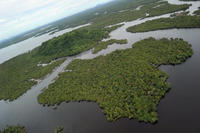-
Asteroid hunter spacecraft returns first images after reactivation
In 2010 and early 2011, NASA’s Near-Earth Object Wide-field Infrared Survey Explorer (NEOWISE), a spacecraft that made the most comprehensive survey to date of asteroids and comets, discovered more than 34,000 asteroids and characterized 158,000 throughout the solar system. It was reactivated in September following thirty-one months in hibernation, to assist NASA’s efforts to identify the population of potentially hazardous near-Earth objects (NEOs).
-
-
Sandia to show Mine Rescue Robot at 2013 DARPA Robotics Challenge
Engineers from Sandia National Laboratories will demonstrate real-world robotics successes at the DARPA Robotics Challenge Trials 2013 Expo this week (20-21 December) in Florida. The challenge is focused on human-scaled robots that assist in humanitarian aid and disaster response. Sandia engineers will demonstrate the Gemini Scout Mine Rescue Robot, which was designed to overcome dangers lurking in a mining accident: poisonous gases, flooded tunnels, explosive vapors, and unstable walls and roofs. Such potentially deadly conditions and unknown obstacles can slow rescue efforts to a frustrating pace.
-
-
Exploring geoengineering research, ethics, governance
Hacking the Earth’s climate to counteract global warming — a subject that elicits strong reactions from both sides — is the topic of a December special issue of the journal Climatic Change. A dozen research papers include the most detailed description yet of the proposed Oxford Principles to govern geoengineering research, as well as surveys on the technical hurdles, ethics, and regulatory issues related to deliberately manipulating the planet’s climate.
-
-
Japan tsunami exacerbated by landslide

The 2011 Japan tsunami, which killed up to 20,000 people and caused the partial meltdown of the Fukushima nuclear plant, was made worse by an underwater landslide, according to scientists. “The earthquake alone cannot explain the height of the waves along the Sanriku coast of northern Honshu Island,” says one scientist. “They were generated by a submarine landslide.” The research poses a big problem for early-warning systems, because where the risk of landslides goes unrecognized, tsunamis generated by similar earthquakes could be seriously underestimated.
-
-
Enjoy it while you can: 850 million more years before oceans boil away

Scientists had estimated that the Earth’s oceans would boil away in about 150 million years. The reason: the sun expands as it runs out of hydrogen fuel, and that expansion, 150 million years from now,would cause “runaway” global warming leading to the boiling of the oceans. Scientists have now found that the Earth’s “Goldilocks Zone” — where it is neither too hot nor too cold for liquid to exist on a planet orbiting a star— is slightly larger than previously thought, meaning Earth has bought itself some additional time — about 700 million years – before the oceans evaporate.
-
-
DHS announces expansion of cyber student volunteer initiative
DHS the other day announced the launch of the 2014 Secretary’s Honors Program (SHP) Cyber Student Volunteer Initiative for college students. Through the program, more than 100 unpaid student volunteer assignments will be available to support DHS’ cyber mission at local DHS field offices in over sixty locations across the country.
-
-
Uranium found to be mobile in a natural wetland

Because they are known to mop up pollutants, artificial wetlands are considered to be an efficient strategy to contain waterborne uranium. Studying a natural wetland near a former uranium-mining site in the French region of Limousin, however, researchers have found that under certain circumstances, uranium can be partly remobilized into the surrounding water. The researchers show how it becomes mobile again by binding to tiny metallic and organic compounds with a little help from ambient bacteria.
-
-
Shot spotting system helps Stockton, Calif. Police reduce gunfire
ShotSpotter sensors detect gunfire, then immediately transmit a signal to control center where technicians use triangulation to locate the spot of origin of the firing to within five to ten feet. The technician reports the location within thirty to forty seconds to the police to dispatch officers to the scene. Stockton, California police has been using ShotSpotter for nine months now, and the police chief says the system has helped reduce gunfire in the covered area by fifty percent.
-
-
Collapse of the universe closer than previously thought

Maybe it happens tomorrow. Maybe in a billion years. Physicists have long predicted that the universe may one day collapse, and that everything in it will be compressed to a small hard ball. New calculations by physicists now confirm this prediction — and they also conclude that the risk of a collapse is even greater than previously thought.
-
-
Motivating pupils to maintain interest in math, science
The lack of interest in math or natural sciences is one of the most frequently voiced causes for concern in the debate surrounding education, at least in Germany. It has been seen time and again that pupils lose their enthusiasm for physics, chemistry, and math once they reach eighth or ninth grade. Is this inevitable, however? If not, how can teachers steer a different course? Researchers create professional development program to promote open dialog in the classroom – an alternative to the rigid style of communication most science teachers use to get their subjects across.
-
-
U.S. loses clean electricity as nuclear power plants keep closing
Four nuclear power plants, sources of low-emissions electricity, have announced closings this year. The main reason: the increasing availability of cheap natural gas as a result of fracking. If plants continue to shut down instead of extending operations, the United States risks losing 60 percent of its clean electricity starting in 2030, according to a new report by the American Physical Society (APS). The APS calls on socially responsible investors to encourage utilities to consider carbon emissions in business decisions.
-
-
Post-Sandy study shows a polluted but largely intact barrier system off Long Island
As coastal communities continue to rebuild in the wake of Hurricane Sandy, scientists last week reported some encouraging news: The storm did not seriously damage the offshore barrier system that controls erosion on Long Island. Long-term concerns remain about the effects on the region of sea-level rise, pollutants churned up by the storm within back-barrier estuaries, and the damage closer to shore, but in the near-term, Long Island residents can rebuild knowing that Hurricane Sandy did not significantly alter the offshore barrier systems that control coastal erosion on the island.
-
-
Scrapping sea level protection puts Australian homes at risk
As the science on the coastal impacts of climate change gets stronger, the protections for Australia’s coastal communities are getting weaker. Along the eastern seaboard of Australia, where most Australians live, state governments are relaxing their policies and largely leaving it to local councils to decide if homes can be built in low-lying areas.Over the past fifty years, there have been twenty-five national inquiries and reports into coastal management. Those inquiries have overwhelmingly come to the conclusion that rather than leaving it to local councils, Australia needs one set of clear, national guidelines on coastal development and infrastructure. That is the opposite of what we are now seeing around Australia, with a mish-mash of different rules in different states. If that continues, everyone will pay.
-
-
Food security and self-provision of major cities
Wealthy capital cities vary greatly in their dependence on the global food market. The Australian capital Canberra produces the majority of its most common food in its regional hinterland, while Tokyo primarily ensures its food security through import. The Copenhagen hinterland produces less than half of the consumption of the most common foods. For the first time, researchers have mapped the food systems of capital cities, an essential insight for future food security if population growth, climate change, and political instability will affect the open market.
-
-
Global map predicts giant earthquakes
Researchers have developed a new global map of subduction zones, illustrating which ones are predicted to be capable of generating giant earthquakes and which ones are not. The research comes nine years after the giant earthquake and tsunami in Sumatra in December 2004, which devastated the region and many other areas surrounding the Indian Ocean, and killed more than 200,000 people.
-
More headlines
The long view
Are We Ready for a ‘DeepSeek for Bioweapons’?
Anthropic’s Claude 4 is a warning sign: AI that can help build bioweapons is coming, and could be widely available soon. Steven Adler writes that we need to be prepared for the consequences: “like a freely downloadable ‘DeepSeek for bioweapons,’ available across the internet, loadable to the computer of any amateur scientist who wishes to cause mass harm. With Anthropic’s Claude Opus 4 having finally triggered this level of safety risk, the clock is now ticking.”
A Brief History of Federal Funding for Basic Science
By Jake Miller
Biomedical science in the United States is at a crossroads. For 75 years, the federal government has partnered with academic institutions, fueling discoveries that have transformed medicine and saved lives. Recent moves by the Trump administration — including funding cuts and proposed changes to how research support is allocated — now threaten this legacy.
Bookshelf: Preserving the U.S. Technological Republic
By John West
The United States since its founding has always been a technological republic, one whose place in the world has been made possible and advanced by its capacity for innovation. But our present advantage cannot be taken for granted.
Autonomous Weapon Systems: No Human-in-the-Loop Required, and Other Myths Dispelled
“The United States has a strong policy on autonomy in weapon systems that simultaneously enables their development and deployment and ensures they could be used in an effective manner, meaning the systems work as intended, with the same minimal risk of accidents or errors that all weapon systems have,” Michael Horowitz writes.
Ukraine Drone Strikes on Russian Airbase Reveal Any Country Is Vulnerable to the Same Kind of Attack
By Michael A. Lewis
Air defense systems are built on the assumption that threats come from above and from beyond national borders. But Ukraine’s coordinated drone strike on 1 June on five airbases deep inside Russian territory exposed what happens when states are attacked from below and from within. In low-level airspace, visibility drops, responsibility fragments, and detection tools lose their edge. Drones arrive unannounced, response times lag, coordination breaks.
Shots to the Dome—Why We Can’t Model US Missile Defense on Israel’s “Iron Dome”
By Justin Logan
Starting an arms race where the costs are stacked against you at a time when debt-to-GDP is approaching an all-time high seems reckless. All in all, the idea behind Golden Dome is still quite undercooked.
